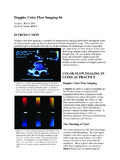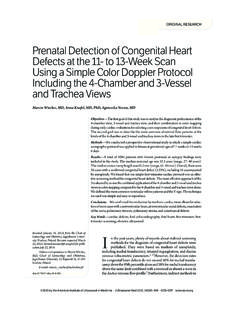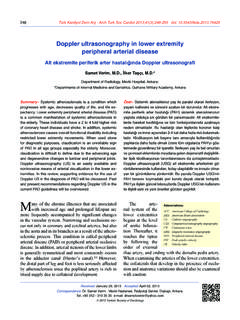Transcription of Ultrasonography in Hydronephrosis - ultrasound.or.kr
1 Ultrasonographyin HydronephrosisUltrasound is very sensitive in diagnosing obstruction by demonstrating Hydronephrosis (1, 2). Ultrasonographyhas great advantage over IVU in patients who have azotemia, contrast material-induced allergy, are pregnant, fetal, or pediatric patients with no exposure to radiation. And ultrasonographycan nicely visualize the both the renal parenchyma and the collecting system as well as causative lesion itself (both intrinsic and extrinsic). Hydronephrosisis graded as mild (grade 1), moderate (grade 2), or sever (grade 3) (3). Mild hydronephrosiscan be simulated by prominent renal vessels and false-positive studies for obstruction are common in patients suspected of having mild Hydronephrosis .
2 Dopleror color Doppler ultrasonographywill distinguish prominent renal vessels from mild Hydronephrosis (Fig 1).ChoSong-Mee, Kyung-Sik ChoDepartment of Radiology,AsanMedical Center, University ofUlsanCollege of MedicineFig. 1. False-positive study for obstruction, which is suspected of having mildhydronephrosis. Fig 1a. The renal pelvis andcalycealsystem demonstrate minimal separation of the central sinus echo complexby tubular anechoic structure. Fig 1b. Color Dopplerultrasounddemontratecolor flow in the tubular 1aFig. 1bWhenhydronephrosisis seen, every effort should be made to determine the level of obstruction. Proximal and distal obstructing lesions will often be visualized, whereas obstruction in themidureteris difficult to delineate. Doppler ultrasound has been suggested as a means to separate obstructive fromnonobstructive Hydronephrosis .
3 The RI normally is less than , but in obstructed kidneys is usually increases above this level. Some investigators have demonstrated up to 92% sensitivity and 88% specificity by measuring renal arterial RI (4, 5, 6). Evaluation ofureteraljets has also been suggested to help diagnose obstruction (7) (Fig. 2).Fig. 2 Ureteraljet has also been suggested to help diagnose obstruction. In mild case,ureteraljet is not demonstrated. Fig 2a. On this image, the renal pelvis andcalycealsystem become apparent as the collecting system distends mildly with urine. Fig 2b. On the scan at the bladderureteraljet is noted. Fig. 2aFig. 2b UreteropelvicJunction ObstructionThe ureteropelvicjunction (UPJ) obstruction is a relatively common congenital anomaly. The US findings include a dilated renal pelvis that ends abruptly at the UPJ (Fig.)
4 3). The amount of residual renal parenchyma will be variable and depends on the degree and duration of the obstruction. Fig. 3aFig. 3bFig. 3 Theureteropelvicjunction (UPJ) obstruction with chronichydronephrosis. Fig 3a. Longitudinal scan of the kidney shows moderate or severe distention of the collecting system, with thinning of thecortical parenchyma. Fig 3b. On the scan of the renal pelvis, a capaciousrenal pelvis gives off markedly dilated calyces. The collecting system distension ends abruptly at the UPJ. Hydronephrosisof PregnancySixty to 80% of pregnant patients will develophydronephrosison the right and 30% havehydronephrosison the left (8). Differentiating normalhydronephrosisof pregnancy from obstruction can be clinically andsonogrpahicallydifficult.
5 If the left is more dilated, an obstructing lesion such as stone should be suspected (Fig. 4). A recent study demonstrated that theRIsof the kidneys in pregnant patients were less than and symmetric, even if the right side was significantly more dilated than the left (9, 10). Renal stone diseaseRecent studies have demonstrated approximately 80% sensitivity to detect stone. (11, 12) Haddad et al recently reported that US combined with plain radiography may be able to replace intravenous urographyin the evaluation of patients with suspected urolithiasis. US will document hydronephrosisand also visualize the stone in many cases, especially those calculi lodged at the UPJ or UVJ. The Plain film can be used to evaluate and follow a suspected stone (13). Fig. 5 Vesicoureteralreflux is detected only in contrast-enhanced voiding conogramin this case.
6 Longitudinal sonograms of the left kidney before (Fig 5a.) and after (Fig 5b.) the administration of the echo enhancer into the bladder illustrate reflux of the microbubblesinto the dilated pelvis and calyces of the left kidney, while VCUG (Fig 5c) could not detected vesicoureteralreflux into the renal , Carroll BA, Bowie JD, et al. Doppler US assessment of maternal kidneys: analysis ofintrarenal resistivityindexes in normal pregnancy and physiologicpelvicaliectasis. Radiology 1993; 186:689-692 ,MahranMR,AbdulmaaboudM. Renal colic in pregnant women: role of renal resistive index. Urology 2000; 55:344-347 C,PerrellaRP,KaveggiaLP, et al. Detection of renal stones with real-timesonography: effects of transducers and scanning parameters. AJR 1991; 157:975-98012. Erwin BC, Carroll BA,SommerFG.
7 Renal colic: the role of US in initial evaluation. Radiology 1984; 152:147-150 ,SharifHS,ShahedMS, et al. Renal colic: diagnosis and outcome. Radiology 1992; 184:83-88 ,VogtS,PatzerL, et al. Contrast-enhancedsonographyofvesicourete rorenalreflux in children: preliminary results. AJR 1999; 173:737-740 ,TroegerJ,DuettingT, et al. Reflux in young patients: comparison of voiding US of the bladder andretrovesicalspace with echo enhancement versus voidingcystourethrographyfor diagnosis. Radiology 1999;210:201-207 ,RupichRC,KirulutaHG. Enhanced detection ofvesicoureteralreflux ininfactsand children with use of cyclic voidingcystourethrography. Radiology 1992184:753-755 References1. EllenbogenPH,ScheibleFW, Tanner LB, et gray-scale ultrasound in detecting urinary tract obstruction. AJ R 978;130:731-7332. Stuck KJ, White GM,GrankeDS, et al.
8 Urinary obstruction inazotemicpatients: detection bysonography. AJR 1987: 149;1191-11933. KriegshauserJS, Carroll BA. The urinary tract. In:RumackCM, Wilson SR,CharboneauJW, eds. Diagnostic ultrasound St. Louis:MosbyYear Book, 1991;2424. Platt JF, Rubin JM, Ellis JH, et al. Duplex Doppler US of the kidney: differentiation of obstructive from nonobstructivedilation. Radiology 1989; 171:515-5195. Rogers PM, Bates JA, Irving HC. IntrarenalDoppler ultrasound studies in normal and acutely obstructed kidneys. Br J Radiol1992; 65:207-212 6. BudeRO, Platt JF, Rubin JM. Dilated renal collecting systems: differentiation of obstructive from nonobstructivedilation using duplex Doppler ultrasound . Urology 1991; 37:123-125 7. Baker SSM, Middleton WD. Color Doppler sonographyof ureteraljets in normal volunteers: importance of the relative specific gravity of urine in the ureterand bladder.
9 AJR 1992; 159:773-775 8. Fried AM, WoodringJH, Thompson OJ. Hydronephrosisof pregnancy: a prospective sequential study of the course of dilation. J ultrasound Med 1983; 2:244-247 Reflux nephropathyVesicoureteral relux(VUR) most commonly affect young girls and has a tendency to resolve as the patient gets older. Reflux is graded from mild to sever, grade I through grade V. The affected kidney is shrunken, with irregularly scarred margins, and a dilated collecting system. Sonographywill show the small, irregular, scarred kidneys with diffuse irregular cortical loss. With the recent use of contrast material(Levovist@), ultrasonogram(Fig. 5) is a alternative to vesicocystourethrogarm(VCUG) for the evaluation for vesicourethralreflux in pediatric patients without exposure of radiation.
10 Fig. 4 pregnant patients withhydronephrosisFig 4a. The scan on the level of left kidney shows moderatehydronephrosis. Fig 4b. A strongechogenicfocus with posterior acoustic shadowing is noted at theureterovesicaljunction. The upstreamureteris distended. Fig 4c. Transversetransabdominalsonogram demonstrates the early embryo in the amniotic cavity. Fig 4d. TheRIsof the kidneys in pregnant patients were more than Fig. 4cFig. 4







